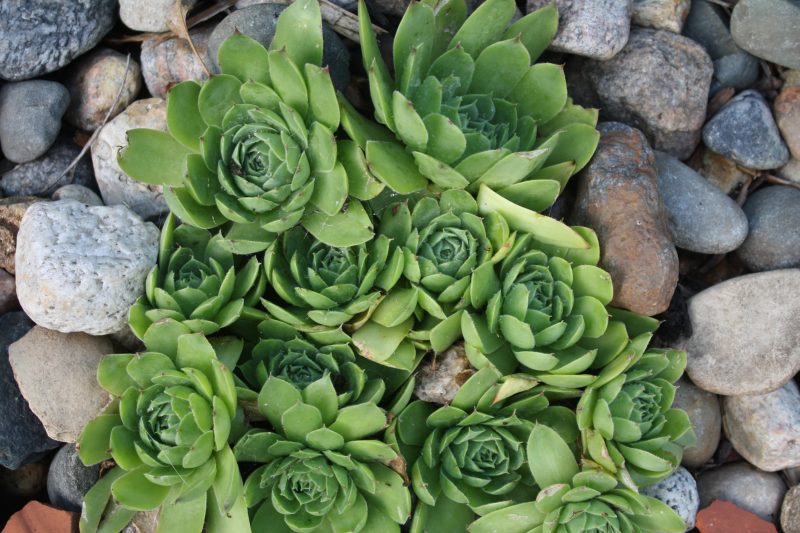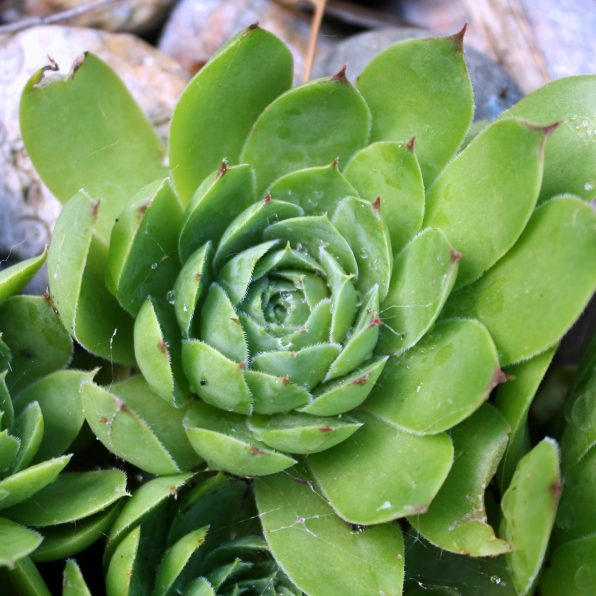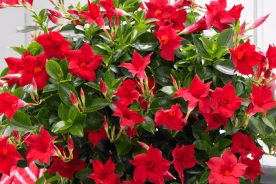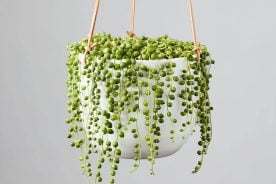Succulents are the perfect plant for forgetful and sometimes neglectful gardeners. They don’t require much care and are easy to grow inside as well as out. They come in a variety of colors and textures and look lovely potted or landscaped.
- What are succulents?
- Succulent types
- Succulent care
- Propagating succulents
- Identifying succulents
- Indoor Succulents
- Outdoor Succulents
- Planting succulents
- FAQ
- What is the difference between cactus and succulent?
- How to care for succulents
- How often to water succulents
- Soil for succulents
- How to propagate succulents
- How to plant succulents
- What kind of succulent pots should I use?
- What kind of succulent pests should I look for?
- How do I know if I can grow this succulent outside?
What are succulents?
Succulents are a diverse group of plants that come in many colors and shapes. There are over 20,000 varieties with kinds suited for all growing conditions. They store water in their leaves which tend to be thick and plump, although some have thinner leaves. They often grow in dry climates without much humidity. They do need to be watered, but can stand periods of drought instead pulling water that is stored in the leaves. They do not do well in wet conditions as their roots will start to rot if sitting in water for too long. Succulents often prefer warm weather can will not survive freezing temperatures. The stored water in the leaves will freeze and destroy the plant. Some species, however, can survive a freezing winter.
Succulent types
The most common types of succulents that you’ll be able to find are agaves, yucca, aloe, cacti, bromeliad, sedum, sempervivum, echeveria, euphorbias, and even some orchids.
Agaves
Agave succulents have long-leaves and form a rosette shape. The produce cup-shaped flowers that grow in a spire. Agaves are a perennial that is suitable for some outdoor gardens. They are naturally drought tolerant. Most types are native to North America and can be grown in colder climates. The most common types of agave succulents include yucca, ponytail palms, century plant, and the dracaena houseplant.
Yucca
Yucca is an agave succulent that is native to the southwestern United States. Some varieties can withstand cold temperatures and is hardy up to zone 4. Yucca is a perennial plant that stays evergreen all year round. It grows tall, spikey leaves that grow in a rosette pattern. The leaves can be sharp so plant in a low-traffic area. The flowers are creamy white and bloom in late summer.
Aloe
Aloe is a type of succulent that has been grown for many years with aloe vera being the most popular. The plant features long, fleshy leaves with spikey points on the edges of the leaf. The gel found inside the leaves is often used for medicinal purposes such as pain relief when applied to a burn. Aloe vera is grown as a house plant and should be grown in a pot with well-draining soil and drainage holes.
Cacti
Cacti are often confused as the only type of succulent there is. The easy way to think of it is that all cacti are succulents, but not all succulents are cacti. Cacti require very little maintenance making them excellent for landscaping. When selecting a location in your yard look for a sunny place with a slight slope to aid in drainage. They are also suited for many different climates with some varieties able to grow as far north as Canada. Cacti come in many colors, shapes, and sizes. Some are tall columns and other are short balls covered in spines. Many produce attractive flowers. The most popular types of cactus are prickly pear cactus, barrel cactus, pincushion cactus, and totem pole cactus. Prickly pear cacti are the ones that will most often be suited for the far north.
Bromeliad
Bromeliads are tropical-looking house plants that offer texture and color to an indoor garden. They are native to North, South, and Central America, but often are kept as houseplants and they can’t tolerate temperatures lower than 50 degrees Fahrenheit. Bromeliad leaves are thick, sword-like and grow in a rosette. They produce flowers that vary widely in color and are one of the most colorful succulents available. Bromeliads grow best in medium to bright light in shallow pots with drainage holes.
Sedum
Sedum succulents are a wonderful outdoor succulent that come in many varieties. They grow well in places that many other plants won’t tolerate such as locations that receive too much sun and not enough water. Most sedums are low to the ground and are used as ground covers. Others can get as tall as a couple feet and don’t spread as much. The lower sedum is easy to plant; just place the sedum on the ground and it will begin to grow by sending out roots wherever it is touching soil.
Sempervivum
Sempervivum succulents are low-growing plants that grow as rosettes and come in a variety of hues. They are low-maintenance and are perfect for the areas in the yard where nothing else will grow such as those that are too rocky or sunny. Some produce star-shaped flowers that come in red, pink, or yellow. The leaves can be green, red, or purple with spikes on the edges.
Echeveria
Echeveria succulent leaves are thick, fleshy, waxy, and grow in a rosette. The leaves can be colored and are delicate. A firm squeeze can leave marks. The plants are slow growers and usually don’t grow more than 12 inches in height or spread. Echeveria are native to the southern United States and Central America. They prefer desert-like conditions, but can tolerate some moisture. If you live in an area that produces more rain it would be best to grow these in a pot that will drain well and dry quickly.
Succulent care
As with all plants the four things to consider when caring for succulents are water, light, soil, and temperature.
Light
Both indoor and outdoor succulents generally need at least 3 hours of direct sun daily. Morning sunlight would be preferable as the afternoon sun can be too harsh. Some succulents that receive too much sun may be damaged and look sunburned with scars on their leaves or a washed out color. Especially in hot climates where the sun is the most direct be sure to keep your succulents in areas with filtered sunlight.
Alternatively, succulents that don’t receive enough sun may begin to grow or reach toward the sun. The plants may begin to grow tall with the leaves more spaced out. Succulents that are colored may also turn green if not receiving enough light.
Water
Succulents are made to grow in arid climates and as a result do not need much water. They instead store their water in their leaves or stems. When watering your succulents be sure the soil is dry before you water. Soak the soil around the plant and don’t water again until the soil is completely dry. If the roots stay wet for long periods of time they may begin to rot causing the plant to rot. You will be able to tell this is occurring because the leaves will turn black and mushy and may start to grow mold. Generally, most succulents need to be watered only once a week. This will vary depending on your climate and soil conditions. If you are unsure how often to water your succulents it is better to underwater rather than overwater.
Soil
Well-draining soil is vital for succulents. This is important as too much moisture will cause the plant to rot. Unlike typical plants, succulent roots don’t absorb water through direct contact, but instead they get their water from the air. That is why well-draining soil is important. If you grow your succulents in pots, but sure the pot has drainage holes.
When planting succulents look for cactus mix potting soil. This mix is designed to drain better than regular potting soil. If you are unable to find cactus mix you can make your own by mixing 1 part stone pebbles, 1 part wood mulch, and 1 part clay pebbles. The stone pebbles don’t absorb water and create pockets in the mix for the water to drain. The mulch and clay absorb moisture and slowly releases it allowing the roots to receive water.
Temperature
Most succulents are able to tolerate a large range of temperatures if they get the right amount of sun and water. However, the more delicate succulents should not be kept in temperatures above 95 degrees Fahrenheit or below freezing. These are the types with really thick leaves. The extreme heat will cause them to droop when the soil gets too hot and dry and below freezing will freeze the water in their leaves.
Propagating succulents
One of the excellent qualities of succulents is their ability to propagate easily. You can often start a new plant from leaf or a plant cutting. Some types of succulents propagate better from a cutting rather than a leaf. The succulents with the thick, fleshy leaves are best suited to leaf propagation.
The best way to remove a leaf for propagation is to gently twist the leaf from the stem. You’ll want the entire leaf so nothing should be left on the stem. For succulents that propagate best from cuttings use sharp scissors or pruning shears and cut off a stem right above a leaf. This can be either the top of the succulent, or a new shoot.
After removing the leaf or cutting you’ll want the end to dry out and scab over a bit before planting. If you plant it freshly cut it may absorb too much moisture. Depending on your climate and humidity this may take 1-3 days. The leaf or cutting may shrivel slightly. You’ll want to plant it before it dries out too much.
When the end of the cutting is dry it is time to plant it. The leaf does not need to be planted and instead should be laid on top of soil. Mist the cutting or leaf with water whenever the soil is dry. You do not need to soak the soil. The leaves will begin to grow tiny roots within 4-6 weeks. When you begin to see roots cover them with soil so they don’t dry out. Propagating new plants from leaves and cuttings is not a quick process as it may take up to a year for the new plant to be fully grown.
Identifying succulents
Often times when you buy a succulent at the store it may not be labeled. Or it will be labeled simply as ‘succulent’ or ‘succulent variety.’ This can be frustrating as different succulent have different growth requirements. There are many avenues you can take to help you identify your plant. The first may be to simply ask the seller. If they are unsure you may be able to identify your succulent with a photo using an online forum.
The more difficult way to identify your succulent is to look at the characteristics of the plant such as leaf shape and growing habits.
Leaf shape
Succulents come in many shapes, sizes, and colors. The leaf shapes of succulent can vary greatly among the different kinds. Leaves are generally long and spikey or small and circular. Succulents that have long spikey leaves include Aloe vera, agave, and gasteria. Within the spikey-leaved category the leaves may be grass-like or fleshy. The succulents with circular leaves are rose-shaped, called rosette forming succulents. Rosette-forming, circular leaved succulents include aeonium, echeveria, and graptopeltum.
Rosette type
Succulents that grow in the rosette-form feature close clusters of leaves that radiate from the center as a flower would. These leaves may be pointed or round, fleshy or grass-like. Jobivarva succulents feature rounded leaves and hen-and-chick feature pointed leaves.
Configuration
Some succulents grow in long stalks and others grow close to the ground and spread out. Succulents may change in configuration as they mature so waiting until they have aged may help in making an identification.
Plant size
The size of the plant may help you identify the plant as well as determine where it should be grown. Smaller plants, those that are just a couple inches tall and wide, may be best suited indoors. Larger plants may be best to grow outside.
Flower shape and color
Flowers are one of the easiest ways to identify a plant. If your succulent blooms pay attention to the shape, size, color, and even the time of year that it blooms. The Christmas cactus, for example, blooms only once a year, in midwinter.
Indoor Succulents
Succulents are a popular choice for houseplants because they don’t require a lot of maintenance. A jade plant is a classic choice and is easy to grow. Aloe vera is also popular and can be used to treat sunburns or wounds. Burro’s tail is a pretty plant that can add some interest to your interior. It has overlapping leaves which can reach up to 3 feet in length and hang over the flower pot.
Christmas cactus and Thanksgiving cactus are succulents that bloom during the holidays and offer some color during the time of year when it can be hard to find. Keep this succulent outside in a sheltered area in the summer and fall. Bring it indoors when the overnight temperatures begin to drop into the 40s. Fertilize the plant three times during the summer and keep it drier in the winter than in the spring and summer.
One of the easiest houseplants to keep is the snake plant. It gets its name from the shape of its leaves. This is an indestructible houseplant that strives on neglect. It grows upright and can fit into many locations in the home. There are also many varieties, some that are variegated in color, to offer many options.
Outdoor Succulents
The most common succulents you’ll find to grow outside are yucca, prickly pear cactus, and agave. These plants are great for landscaping and can be used alone or for all of the landscape. Yuccas and agave are hardy for most of the United States.
Hen-and-chick are a type of sempervivum and get their name from the mother plant, or the hen, that produces cluster of offsets, the chicks. They are an easy plant to grow in the sunny part of the yard. They are low-growing and are also a good choice for a houseplant. When keeping it as a houseplant be sure to let the soil dry out completely between watering.
Sedum, sometimes called stonecrop, are a great succulent to use as groundcover as most types are low-growing. Some varieties are taller and look best in the middle of the garden. They grow well in a normal garden, but do best in drier conditions. They also grow well in full-sun or partial sun.
Planting succulents
When planting succulents in your garden one thing you should pay attention to is the soil. If your soil is not naturally well draining you will need to mix in some sand or gravel to help the drainage. No succulents can tolerate standing water so well-drained soil is key.
To help landscape the succulents consider adding a rock garden. This is a great way to achieve a natural looking succulent garden. Rock gardens feature various sizes of rocks and help mimic many of succulents native habits helping the landscaped succulents look more natural. You can also plant the succulents in groups to help them look purposeful and avoid planting in rows which can create the effect of soldiers in a row.
FAQ
What is the difference between cactus and succulent?
Cacti fall under the broad category of succulents, which are plants that store water in their leaves or stems. All cactus are succulents, but not all succulents are cactus.
How to care for succulents
To care for succulents you’ll need to be sure it receives the right about light and water. Succulents should receive about three hours of sun per day. They don’t need much water and should only be watered when the soil is completely dry. Not all succulent are suited for all climates so be sure to keep your succulent inside if it can’t tolerate cold temperatures.
How often to water succulents
Succulents should only be watered when then soil surrounding the plant is completely dry. Overwatering succulents can lead to root-rot which will kill the plant.
Soil for succulents
Succulents require well-draining soil. To aid the water drainage look for cactus potting soil. If you are unable to find cactus potting soil you can make your own potting mix by mixing together one part wood mulch, one part clay pebbles, and one part stone pebbles. You can also mix stone pebbles into regular potting soil.
How to propagate succulents
Succulents can be propagated from a leaf or stem cutting. Propagate from leaf if it is thick and fleshy. Remove the entire leaf from the stem and place on soil. Mist the leaf when the soil is dry and soon roots will begin to grow. When you see roots plant the leaf in soil and water as you would a mature succulent. Cuttings should be planted right away and should be cut at the top of the plant right above the first leaf. Succulents are slow growers and it make take as long as a year to grow a mature succulent from a leaf.
How to plant succulents
If you plan to grow succulents inside you will not need to do much to plant them. Be sure to use well-draining soil in a pot with drainage holes. If you plan to plant succulents outside be sure to select varieties that are suited to your cold hardiness zone. Plant in the spring or summer when the soil can be worked and be sure to pay attention to the plant label and place the plant in a location that will suit its light requirements.
What kind of succulent pots should I use?
When growing succulents in pots be sure to use a porous terra cotta pot with drainage holes and soil that drains quickly. One of the biggest mistakes people often make with potted succulents is overwatering them.
What kind of succulent pests should I look for?
Succulents are, in general, resistant to most pests. Outdoor succulents may have a problem with aphids. Indoor succulents may have problems with mealybugs, fungus, or gnats. Use neem oil to control pests.
How do I know if I can grow this succulent outside?
To determine if your succulent is able to survive the winter where you live you’ll need to know if it is cold hardy. First, you will need to determine what zone you live in. If you buy your succulent at a garden center the plant label will probably tell you what zones the plant is suited for. If the succulent is not suited to grow in your zone you’ll need to bring it inside for the winter.








No Comments